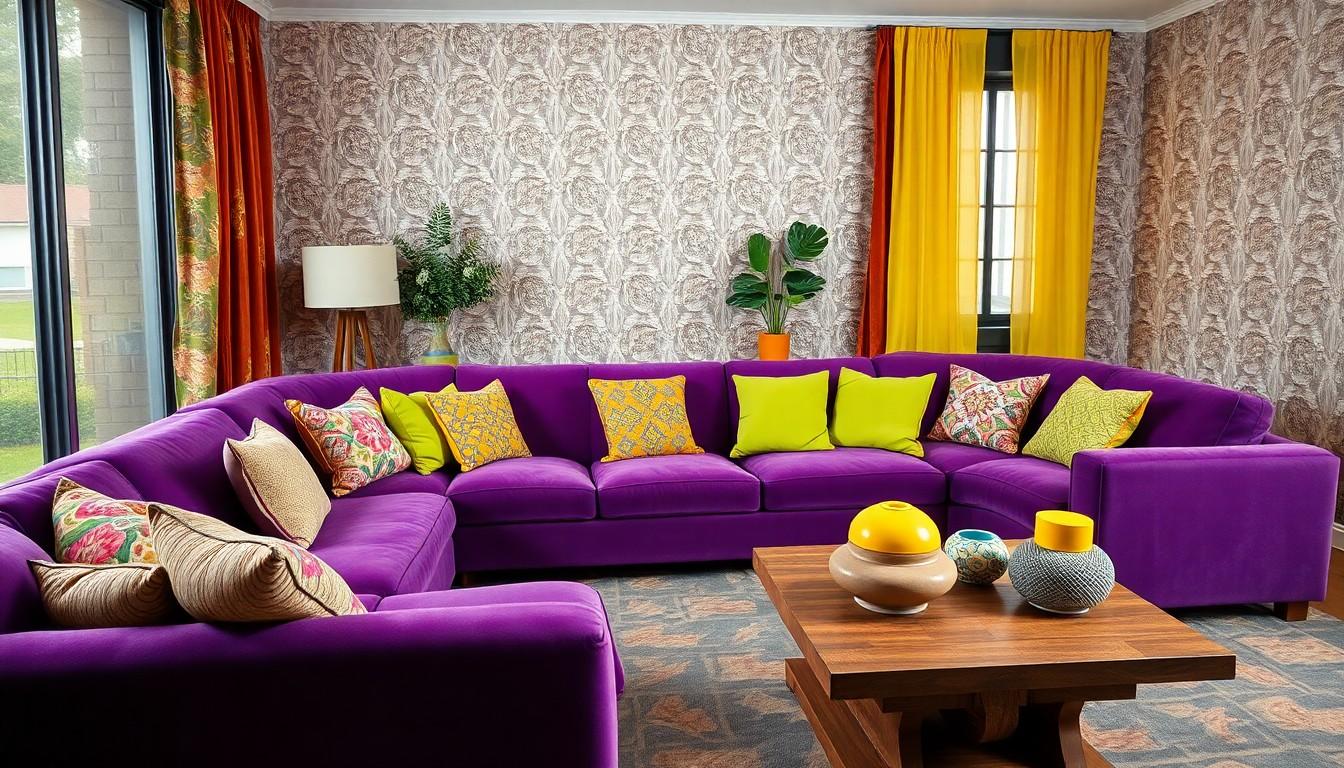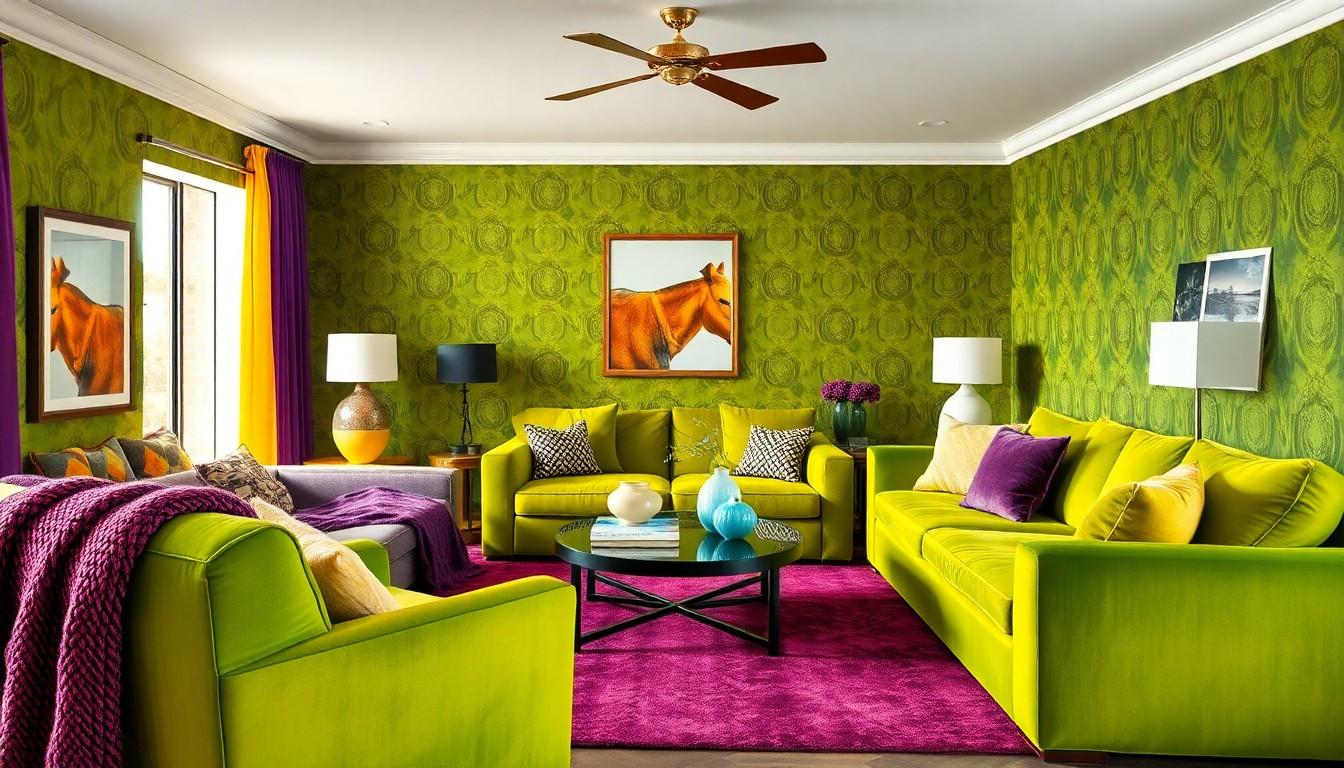Step into the time machine and crank it to the 1990s, a decade where neon colors, oversized furniture, and eclectic patterns ruled the roost. This was a time when living rooms boasted more floral prints than a garden party and kitchen appliances came in shades that could only be described as “bold.” If you thought your grandma’s couch was a relic, think again; it was just a stylish throwback waiting for its moment to shine.
1990s Interior Design
1990s interior design showcased a blend of boldness and eclecticism. Colors like bright greens, purples, and yellows dominated spaces. Oversized furniture pieces, such as plush sofas and large coffee tables, became staples in living rooms. Eclectic patterns emerged as popular choices, often mixing floral motifs with geometric designs. Texture played a vital role, with fabrics like velvet and corduroy enhancing the cozy atmosphere.
Minimalism shifted toward a more layered approach, creating welcoming environments. Accessories multiplied, filling shelves and accent tables with decorative items. Retro elements, including vintage furniture and knick-knacks, infused character into homes. Trendy wall treatments, such as wallpaper featuring large prints, became prominent throughout many living spaces.
Light fixtures transformed into statement pieces, featuring innovative designs that drew attention. Kitchen appliances embraced bold colors, moving away from traditional whites and stainless steel. Many homeowners opted for country-inspired kitchens, incorporating warm woods and farmhouse accents.
Popular trends also included the incorporation of technology, as the emergence of personal computers changed workspaces. Design began to focus on multifunctionality, adapting areas for both leisure and productivity. This versatility reflected the lifestyle changes of the decade, with more families valuing comfort and convenience in their homes.
Key Characteristics of 1990s Interior Design


1990s interior design showcased a unique fusion of bold aesthetics and eclectic influences. The era’s distinctiveness lies in its vibrant colors, varied materials, and textured layers.
Color Palettes
Bright greens, purples, and yellows filled interiors, creating dynamic environments. Neon shades offered playful accents against neutral backdrops, making spaces feel lively. Combination of earthy tones with vivid colors provided a balance, appealing to many homeowners. Floral prints often danced alongside geometric designs, introducing a mix of patterns that defined the decade. These color palettes reflected the era’s spirit, embodying both comfort and creativity.
Materials and Textures
Fabrics like velvet and corduroy dominated furnishings, adding richness to interiors. Soft materials brought warmth, enhancing the coziness of living spaces. Large, plush sofas and oversized chairs encouraged relaxation, becoming essential in homes. Innovative wall treatments featured textural elements, such as wallpapers with raised patterns, elevating aesthetics. Accessories also showcased diverse textures, from chunky knits to sleek ceramics, creating layers of visual interest throughout each room.
Popular Trends in 1990s Interior Design
1990s interior design showcased a diverse range of styles, combining boldness and eclectic influences. Key trends reflected personal expression and comfort throughout living spaces.
Minimalism
Minimalism emerged as a response to the previous decades’ excesses. Clean lines and simple forms defined this aesthetic, creating serene environments. Neutral palettes dominated, with whites and tans enhancing the feeling of spaciousness. Essential furniture pieces were chosen for functionality, often featuring sleek designs without ornamentation. Open floor plans contributed to a sense of airiness, inviting natural light into homes. This approach allowed homeowners to showcase a curated selection of items, emphasizing quality over quantity.
Maximalism
Maximalism celebrated abundance and bold expression. Vibrant colors and playful patterns characterized this trend, often combining various design influences within a single space. Layered textiles provided depth, with everything from plush throw pillows to richly patterned rugs creating visual interest. Oversized furniture defined rooms, inviting relaxation and conversation. Accessories like statement art pieces and decorative lamps contributed to personalized interiors. Contrast between elements fostered an energetic atmosphere, allowing individuality to shine through.
Eclectic Styles
Eclectic styles flourished, blending diverse influences and historical references. Mixing different periods and styles created unique visuals that reflected personal taste. Bright colors alongside rustic elements added charm, establishing inviting atmospheres in various rooms. Homeowners often integrated vintage finds with contemporary pieces, creating harmonious yet surprising combinations. This trend encouraged creativity in home decor, with floral prints, geometric patterns, and varied textures coexisting. An emphasis on personalization allowed every space to tell a story, making eclectic design a hallmark of the decade.
Influential Designers of the 1990s
Designers in the 1990s played crucial roles in shaping the decade’s distinct interior aesthetics. Vern Yip, known for his innovative approach, infused vibrant colors and bold patterns into residential spaces. His work embraced eclectic styles while emphasizing functionality, aligning closely with the trends of the era.
Kelly Wearstler emerged as a notable figure by creating luxurious yet approachable designs. Color palettes often featured deep jewel tones complemented by metallic accents, drawing attention and creating a sense of opulence. Wearstler’s hotels became showcases of 1990s flair, blending style and comfort seamlessly.
David Hicks, a foundational designer, influenced countless interiors with his famed use of bold patterns and harmonious color schemes. His keen eye for mixes of prints transformed interiors into visually engaging spaces, pushing boundaries for homeowners and designers alike.
Martha Stewart’s impact on home design can’t be overlooked. She championed a cozy and inviting look, focusing on accessible elegance. Stewart’s philosophy emphasized warmth and familial connection, encouraging people to craft personalized, meaningful spaces.
Suzanne Kasler introduced a fresh take on traditional design, incorporating contemporary elements. Her use of layered textures and soft hues created serene atmospheres that appealed to many homeowners. Kasler’s work highlighted the importance of balance in decor.
Lastly, Thomas O’Brien’s designs illustrated a blend of vintage and modern styles. His ability to merge eclectic elements fostered spaces filled with personality, aligning with the 1990s’ trend towards uniqueness in interior design. Each designer contributed significantly to the era’s legacy, leaving lasting impressions that continue to inspire today.
Impact of Technology on 1990s Interior Design
Technology greatly influenced 1990s interior design, driving shifts in aesthetics and functionality. The personal computer revolution introduced new possibilities, prompting designers to create multifunctional spaces that catered to both relaxation and work. Living areas often included desks or computer stations seamlessly integrated into the overall design, reflecting the decade’s growing emphasis on convenience.
Innovative materials emerged during this period, enhancing design elements and expanding choices. Advances in manufacturing allowed for affordable furnishings, making bold styles accessible to more homeowners. This accessibility encouraged experimentation with vibrant colors and textures, such as faux finishes and laminate surfaces.
Lighting technology played a crucial role in transforming spaces, with the introduction of energy-efficient bulbs and unique fixtures. Creative light sources, including track lighting and pendant lamps, became common in homes, enhancing ambiance while allowing homeowners to showcase their style. Flexible lighting options supported various moods, from cozy evenings to lively gatherings.
Home entertainment systems also impacted room layouts, leading to the creation of entertainment-focused spaces. Designers prioritized comfortable seating arrangements centered around televisions and audio systems, reflecting changing leisure activities. Consequently, living rooms transformed into multifunctional entertainment hubs that fostered social interactions.
Moreover, the rise of DIY culture, fueled by television shows and magazines, encouraged homeowners to personalize their spaces. Individuals began exploring innovative ideas and techniques, using readily available resources. This trend paved the way for eclectic designs, where personal touches became central to the overall style.
Embracing technological advancements helped shape the bold designs of the decade while maintaining a strong connection to comfort and accessibility. The harmony between innovation and aesthetic choices defined the essence of 1990s interior design.